Instruments part 1
In this guide...
Key terms:
Subscription required!
To view the complete study guide, you will need a valid subscription. Why not subscribe now?
Already have a subscription? Make sure you login first!
Introduction
A good knowledge of instruments, their families, and their capabilities is essential for music theory.
Types of instrument
Musical instruments are made from all kinds of materials: different types of wood, metal, and even plastic.
Instruments made of similar materials, and which are played in a similar way, can be grouped together into families of instruments.
Strings
The majority of instruments in any orchestra are the strings. A member of this familiy is an instrument which:
- ...makes a sound from a vibrating string above a resonant sound-chamber
- ...uses a bow or plucking fingers to set the string vibrating
- Notes are changed by shortening the strings using the fingers of the hand that is not holding the bow or plucking the strings
The orchestral strings are:
- Violin
- Viola
- Violoncello (or simply Cello)
- Double bass (or Contrabass)
All of these use a bow or occasionally fingers (plucking) to produce sound, and normally play just one note at a time.
In addition, we can consider these instruments as members of the string family:
- Guitar
- Harp
Both of these instruments are capable of playing chords, and both are played only by plucking the strings with the fingers (they are never played with a bow!)
Guitars are rarely found in an orchestra, and are not part of the orchestra string family, although there are some famous examples of guitars playing with orchestras (such as Rodrigo's Concierto de Aranjuez).
Harps, on the other hand, are often found in large orchestras, but their function is quite different from the rest of the string section: they are often given solos, and the sound stands out in the texture, whereas the bowed strings function much more as a single, blended texture. The harp does not blend with that string texture, and so is sometimes not considered to be part of the standard orchestral string family.
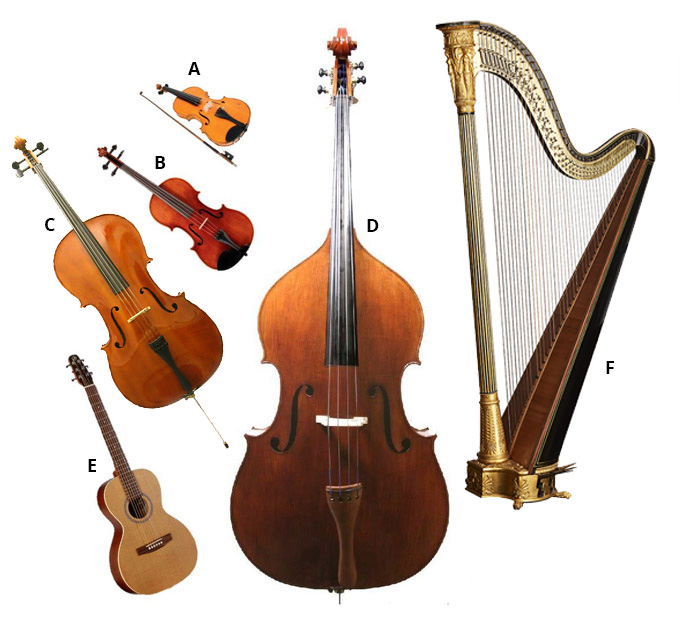 String instruments:
String instruments:A: violin
B: viola
C: cello or violoncello
D: double bass or contrabass
E: guitar
F: harp
In the image above, note the different shapes of the orchestral string instruments. The viola is slightly larger than a violin, but otherwise appears very similar. The cello is much larger, and has a spike which can be extended from the bottom of the instrument, which allows the player to rest it on the floor while playing. The double bass is larger again, and has a very different shape around the "shoulders" of the instrument.
Woodwind
The woodwind instruments were historically all made of wood, although some today are made from metal or different types of plastic. We can characterise instruments in this family as those which:
- ...are (or were historically) made from wood
- ...produce sound by the player breathing into a mouthpiece to cause a column of air to vibrate inside the instrument
- Notes are changed by the covering and uncovering of holes in the body of the instrument
Woodwind instruments found in the orchestra are:
- Flute
- Clarinet
- Oboe
- Bassoon
In addition, the Saxophone is a member of the woodwind family, and although it has never been made from wood, it does share the same kind of mouthpiece as the clarinet, and the same fingering as the flute.
The Recorder is also a type of woodwind, although it is not normally found in the orchestra.
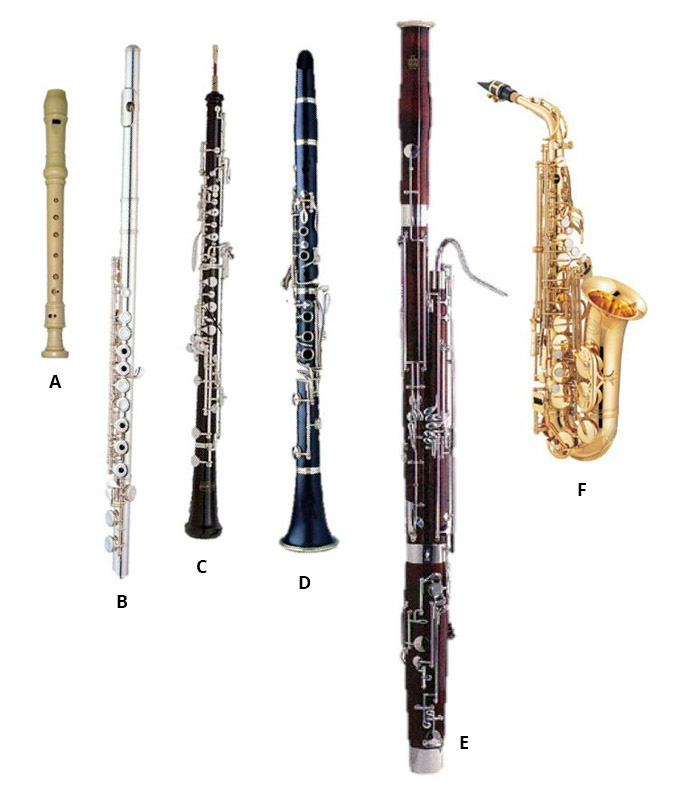 Woodwind instruments:
Woodwind instruments:A: recorder
B: flute
C: oboe
D: clarinet
E: bassoon
F: saxophone
Brass
The brass family of instruments are those which:
- ... are made from metal (either brass or another alloy of metals)
- ... produce sound by the player breathing into a mouthpiece and vibrating their lips, causing air to resonate within the instrument
- Notes are changed by shortening the length of the instrument using keys, valves, or a slide mechanism
The brass instruments found in the orchestra are:
- French horn
- Trumpet
- Trombone
- Tuba
There are many other kinds of brass instrument that are not normally used in the orchestra, but which are commonly found in ensembles such as the brass band.
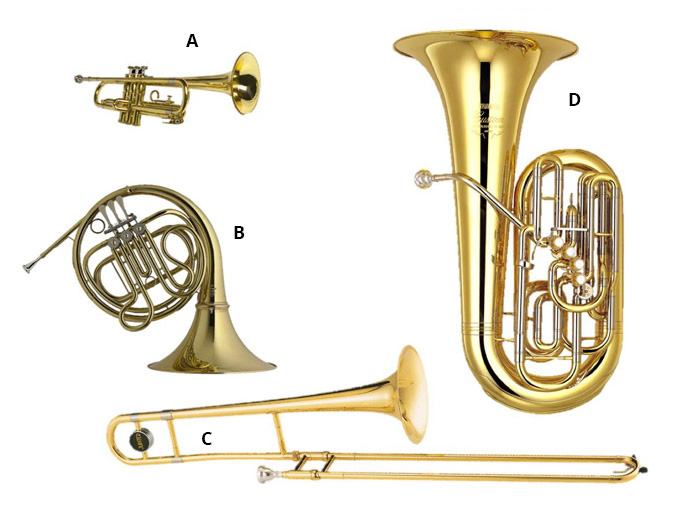 Brass instruments:
Brass instruments:A: trumpet
B: French horn
C: trombone
D: tuba
Percussion
Percussion instruments are those which:
- ... produce sound when struck either by hands or with some kind of stick, beater, mallet, or other implement
- Some produce notes of a definite pitch: tuned percussion and other produce notes of no definite pitch: untuned percussion
The percussion family is extremely large, and especially in recent years all kinds of everyday object have been used as percussion instruments.
In the conventional orchestra, the following are commonly found:
- Timpani (tuned percussion)
- Glockenspiel (tuned)
- Xylophone (tuned)
- Bass drum (untuned percussion)
- Snare drum (untuned)
- Cymbals (untuned)
- Triangle (untuned)
Percussion instruments are found in almost every kind of ensemble imaginable, ranging from the drum kit found in rock bands to the tuned gongs of the Gamelan.
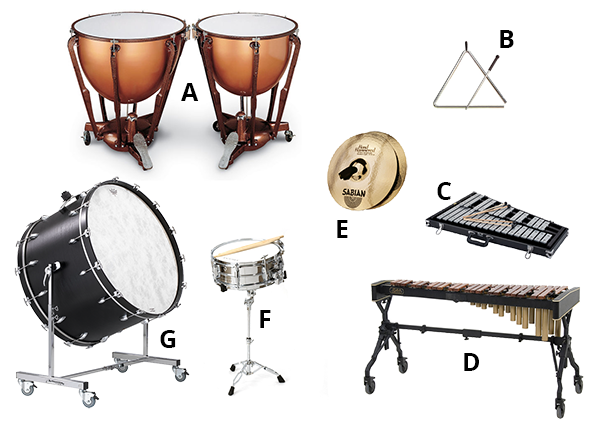 Percussion instruments:
Percussion instruments:A: timpani
B: triangle
C: glockenspiel
D: xylophone
E: cymbals
F: snare drum
G: bass drum
Keyboard
Keyboard instruments are simply those which:
- ... are played via a keyboard, the keys of which cause sound to be produced in one of many ways, either electrically or mechanically
Keyboard instruments are not often found in the orchestra, and include:
- Piano
- Organ
- Synthesizer
- Celesta
- Harpsichord
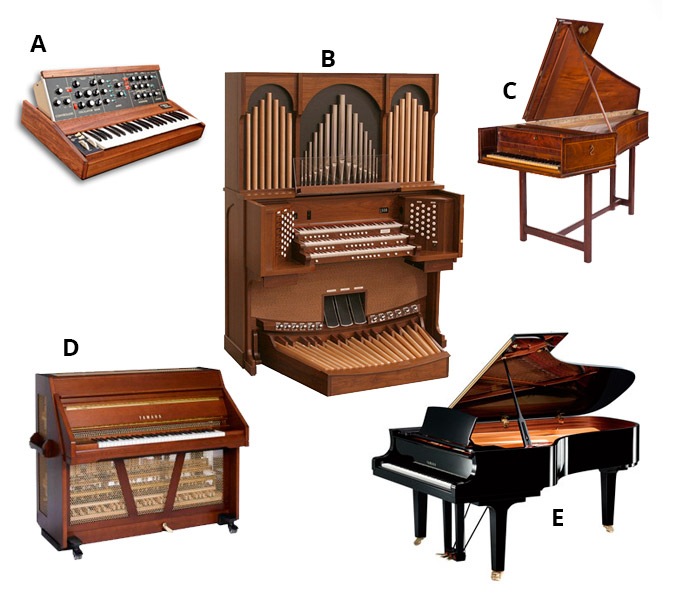 Keyboard instruments:
Keyboard instruments:A: synthesizer
B: organ
C: harpsichord
D: celesta
E: grand piano
Read more...
With a subscription to Clements Theory you'll be able to read this and dozens of other study guides, along with thousands of practice questions and more! Why not subscribe now?
Revision
Are you sure you've understood everything in this study guide? Why not try the following practice questions, just to be sure!